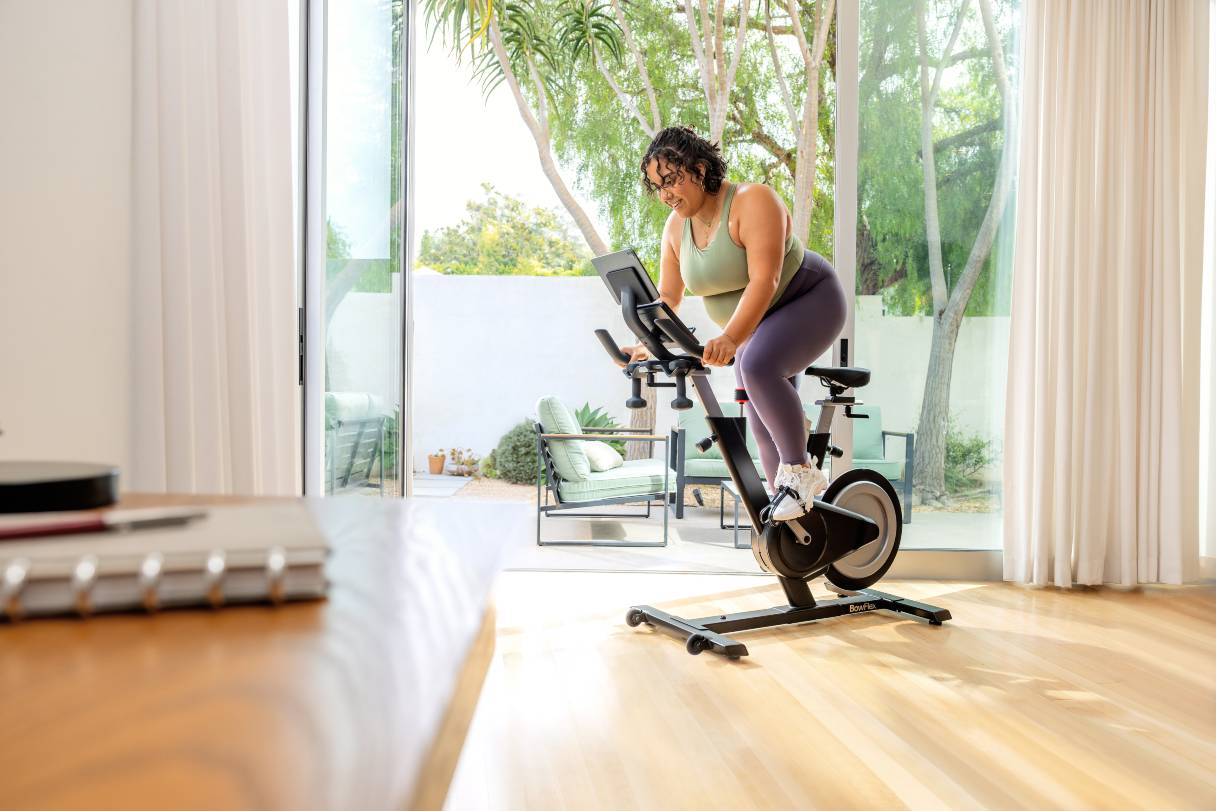For many people, exercising at home has the advantages of convenience, personalization and cost-effectiveness. With a little creativity, you can transform almost any available space in your home into a functional home gym to help you maintain your regular workouts. Use these tips to help you get started.
1. Use a Good-Quality Workout Mat
Investing in a high-quality rubber workout mat is a good idea for several reasons. Your joints will thank you for the extra cushioning, and your floors can be protected from damage caused by weights or other heavy equipment like treadmills, stationary bikes or rowing machines. Some mats also offer soundproofing, which can be a bonus depending on where your exercise space is located.1
2. Add Variety to Your Routine With Resistance Bands
Resistance bands, which come in various sizes and resistance levels, can be a fun and effective way to incorporate strength training into your workout. They are portable, use a minimal amount of storage space and can be as effective for weight training and muscle conditioning as weight machines or dumbbells.2
3. Save Money and Space With Adjustable Dumbbells
A full set of multiple fixed-weight dumbbells can not only be expensive but also require a lot of storage space, which may be in short supply in a home gym. Adjustable dumbbells are compact for easy storage, and they allow you to easily change the weight from light to heavy resistance to accommodate a wide variety of workouts.3
4. Use a Stability Ball for Core Work, Balance and Flexibility
Stability balls are a versatile tool for building core strength and improving muscle tone, balance and flexibility. Use a stability ball to challenge different muscle groups with exercises like planks, bridges and push-ups.4
5. Check Your Form in the Mirror
Using a mirror in your exercise space allows you to monitor your form while working out and adjust as needed to ensure you’re using the proper technique.5 Seeing yourself also allows you to view your progress, which can be motivating.
6. Install a Pull-Up Bar for Upper Body Workouts
Strengthen your upper body, including your back muscles, biceps and core, with a pull-up workout. Pull-up bars can be installed in a doorway or on a wall since they require little space. If you’re new to pull-ups, start with modified movements and small sets to progressively build your endurance and strength.7
7. Take the Stairs
Choosing to take the stairs is a no-fuss way to sneak some extra exercise into your day, especially if you're stuck at a desk job. It's a simple switch that gets your legs working and your heart pumping. Plus, it's a quick win for your health, proving that even the smallest changes in your daily routine can make a big difference in how you feel.8
8. Incorporate Your Body Weight
Another way to build strength and endurance is with exercises that use your body weight, require no special equipment and can be done almost anywhere. Push-ups, squats, lunges, planks, burpees, shoulder presses and core work can provide a total-body workout on demand.9
9. Use Household Items to Add Resistance
Substitute everyday items for traditional dumbbells to add resistance to your workouts. Canned goods, bags of rice or flour and plastic jugs filled with water or sand can stand in as light to medium weights for arm curls, squats or chest presses. You can also customize your level of resistance and fill a backpack with canned goods or books to your desired weight load.10
10. Enhance Your Workout With Music or TV Entertainment
For many, listening to music while working out is not only motivating, but it also makes exercise a more pleasurable experience. A bonus to working out at home is that you’re free to listen to whatever you want. Likewise, a TV in your workout space can come in handy for watching a workout video or the latest episode of your favorite series to pass the time while you’re logging steps on the treadmill.11
11. Set Up a Designated Space With Proper Ventilation and Lighting
Your exercise space doesn’t have to be big or an entire dedicated room, but you need enough space to be able to move freely, practice strength training and stretch.12 Make sure your space is well lit for safety, and keep the air flowing with fans or open windows for a comfortable climate.5
12. Stick to a Consistent Workout Schedule
Carve out time on your calendar to exercise, and set reminders or alarms for added accountability. Working out with a family member or friend — an "accountability partner" — can also help keep you consistent and moving toward your goals.12
13. Incorporate a Variety of Workouts to Prevent Boredom and Plateaus
Mix up your cardio with activities like dancing, jumping rope, stair-stepping, aerobics or whatever gets your heart pumping. Varying your strength training using a combination of body weight, resistance bands and fixed weights can also challenge your muscles as they get stronger.9
14. Warm Up and Cool Down Properly to Help Prevent Injury
Prepare for exercise with some light cardio — like marching in place or jumping jacks — to get the blood moving to your muscles. Add some gentle stretching of the major muscle groups to help prevent injuries. Afterward, cool down with more stretching or yoga, and bring your heart rate down gradually with some light walking.9
Managing Health and Wellness Costs With the CareCredit Credit Card
If you are looking for an option to help manage your health and wellness costs, consider financing with the CareCredit credit card. The CareCredit credit card can help you pay for the care you want and need and make payments easy to manage.* Use our Acceptance Locator to find a provider near you that accepts CareCredit. Continue your wellness journey by downloading the CareCredit Mobile App to manage your account, find a provider on the go and easily access the Well U blog for more great articles, podcasts and videos.
Your CareCredit credit card can be used in so many ways within the CareCredit network including vision, dentistry, cosmetic, pet care, hearing, health systems, dermatology, pharmacy purchases, and spa treatments. How will you invest in your health and wellness next?
Author Bio
Anne-Marie Kennedy is a freelance writer with more than 20 years of experience covering health and wellness, personal finance and real estate/investing.







